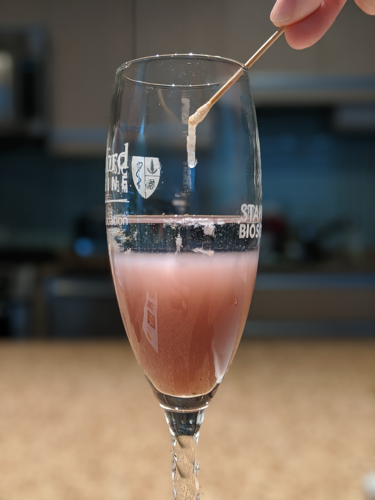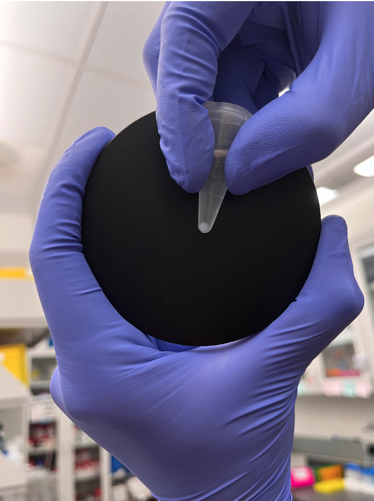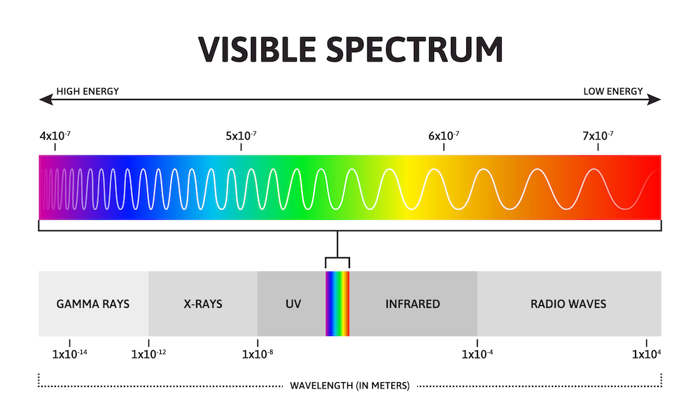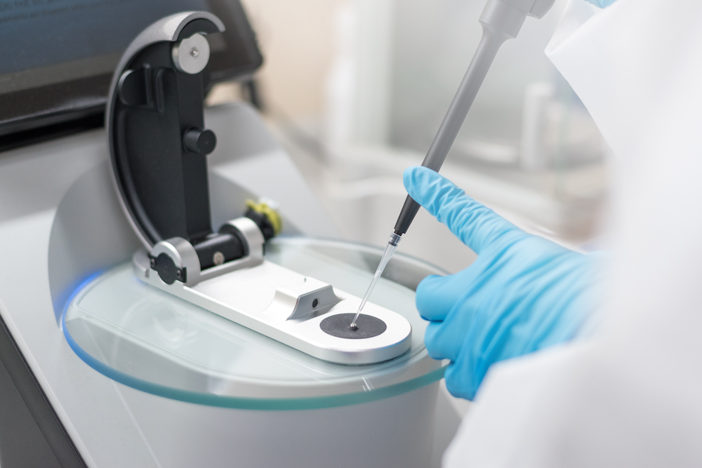
What color is DNA?
June 28, 2024

- Related Topics:
- DNA basics,
- Common questions
A visitor at The Tech Interactive asks:
"What color is DNA?"
If you were to look at a single strand of DNA it wouldn’t have any color! DNA doesn’t interact with colored light. But if you look at a lot of DNA all clumped together, it will usually look white.
Let’s dive into why DNA looks white (or clear!) in large amounts, and what kinds of light waves DNA does interact with.
Looking at a lot of DNA
Even though each individual piece of DNA is very small, if there is enough of it clumped together you can see it with your own eyes. If you have ever collected DNA from a strawberry it looks like this.

All the stringy goopy stuff is DNA, so when you gather a lot of it together, it often looks white. But most of that white color doesn’t come from the DNA itself. Instead, it’s from other “gunk” that’s tangled up with the DNA. Cells have a lot of stuff in them, such as proteins and sugars, that can get pulled out along with the DNA.
If you were to get a super pure DNA in the lab, it would look more translucent or clear like this:

How do things get their color?
But why is DNA white or clear? What causes it to have that color?
What we see as color happens when an object interacts with visible light. Full-spectrum light (like from the sun or a light bulb) is bright white. If an object interacts with that light and changes it in some way, we might see a different color.
We can think of light as a series of energy particles moving in a straight line. When this beam of particles interacts with an object several things can happen:
A) Absorption
Light hits the object and gets partially (or fully) absorbed. If a specific color is absorbed, that will no longer be perceived. For example, leaves absorb most colors except green, so we see them as green.
B) Reflection
Light hits the object and bounces back in the opposite direction. This is how a mirror works. It will bounce back a reflection of light allowing us to see what is in front of it.
C) Refraction/Scattering:
Light hits an object and changes direction. This is how a magnifying glass or microscope works. By bending the light we can make objects appear bigger. Refraction causes the light to bend a specific direction, whereas with scattering the light bends in many directions.

Different colors of light can react differently to the same object. That’s because different colors of light have different amounts of energy.
We can tell the energy of a beam based on its wavelength. Low-energy light has a high wavelength, while high-energy light has a low wavelength. For example, visible light ranges from 380 nanometers (high energy blue light) to 700 nanometers (low energy red light). Other wavelengths are outside the range that we can see with our eyes, like ultraviolet (high energy) and infrared (low energy).

Looking at a single piece of DNA
A single piece of DNA is 2 nanometers wide. That is 25,000x smaller than a single strand of hair. That is almost the same difference in height between the empire state building and a dime!
Even if we were going to look at our DNA with the strongest microscope possible, with visible light we can only see things that are up to 250 nanometers. DNA is too small to be seen with visible light.
And because it is so small, this single piece of DNA wouldn’t scatter very much light. The light would go straight through it without changing, making it essentially invisible.
But if you get a lot of DNA clumped together, it can become large enough to interact with the light. But it doesn’t interact differently with any specific colored wavelengths of light. Instead, DNA will scatter all the visible wavelengths equally. For that reason, we’ll see it as white.
Seeing DNA with UV light
So DNA doesn’t interact much with visible light, which is why we see it as white or clear. But it does interact with some of the higher-energy light waves that we can’t see. Luckily, even though our eyes can’t see those, machines can.
For example, even small amounts of DNA will absorb light in the UV range. So if a scientist has a tube of (clear) DNA in (clear) water, they could put a drop of that into the machine to see how much UV gets absorbed. From that, we can figure out how much DNA is present.

These machines are even more helpful than just allowing us to “see” DNA. Remember how I mentioned that a lot of the white color can be from other gunk, like sugars and proteins? Those contaminants don’t react the same way to UV light. DNA absorbs the strongest at 260 nanometers (though it absorbs across the full range of 230-280 nanometers). Sugars absorb most strongly at 230 nanometers and proteins absorb most strongly at 280 nanometers. So looking at the absorption pattern can tell us both how much DNA we have and how pure it is.
Using these machines allows us to measure even very small amounts of DNA. So even though DNA doesn’t have any color, that doesn’t stop us from being able to extract and perform experiments using it in the lab.

Author: Sidney Vermeulen
When this was published in 2024, Sidney was a PhD student in the Department of Genetics using transgenic tools to study regeneration in flatworms in Bo Wang’s lab. She wrote this while participating in the Stanford at the Tech Program.
 Skip Navigation
Skip Navigation
